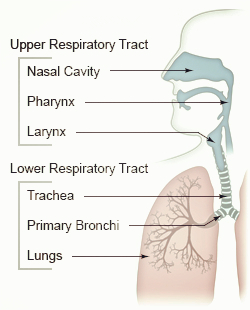The respiratory tract is one of the largest systems in the entire body. It consists of several organs including nostrils, mouth, pharynx, larynx, nasal cavity, and lungs. All throughout the respiratory system you will find a mucous membrane. The purpose of mucus throughout the respiratory system is to trap particles which are inhaled and keep them from circulating through the lungs. These particles include things like hair, pollen, dirt, and smoke. Every time you breathe in air, the mucus in your respiratory system cleans, warms, and moistens the air so that it can successfully fill your lungs and be exhaled. As impressive as the system is, many individuals might wonder where mucus in the upper respiratory tract comes from.
Where Is Mucus in the Upper Respiratory Tract Produced?
 In the upper respiratory tract, mucus is produced by the membrane lining of nasal cavity and sinus cavity, which helps trap foreign particles and lubricate the membranes. In addition, airways (including trachea, bronchus and bronchioles) also produce mucus. The surface issue of the airways is called the epithelium. Within the surface epithelium there are mucus producing cells which are clinically named goblet cells. Below that layer of tissue exists connective tissue which is home to seromucus glands that also aid in mucus production.
In the upper respiratory tract, mucus is produced by the membrane lining of nasal cavity and sinus cavity, which helps trap foreign particles and lubricate the membranes. In addition, airways (including trachea, bronchus and bronchioles) also produce mucus. The surface issue of the airways is called the epithelium. Within the surface epithelium there are mucus producing cells which are clinically named goblet cells. Below that layer of tissue exists connective tissue which is home to seromucus glands that also aid in mucus production.
Each day, the respiratory tract is responsible for producing up to 2 L of mucus. Mucus is composed of lipids, carbohydrates, proteins, and water. Water is the most dominant component of mucus and is essential to properly humidify nasal passages to keep them properly lubricated. The glycoproteins which are found in mucus are derived from plasma.
What's the Function of Mucus?
When pondering the question of "where is mucus in the upper respiratory tract produced", you might also wonder what the purpose of mucus is. The sticky substance we know as mucus serves several purposes, including the following:
- Catching any allergens, dust, pollutants, or germs which are inhaled from the air around you.
- Serving as the first defense system against viruses and bacteria which are airborne.
- Working with cilia to remove foreign particles and eject them from the body.
- Preventing harmful germs and bacteria from entering the lungs.
- Moisturizing the various passages of the respiratory system to ensure they work properly.
- Helping doctors properly diagnose health conditions based on the color of the guests.
Conditions That Cause Respiratory Mucus Buildup
When addressing the question of "where is mucus in the upper respiratory tract produced", it is important to also address what can lead to uncomfortable mucus buildup. This condition can be caused by bad habits, illness, and allergies.
1. Smoking
Smoking has a negative impact on several parts of the body but the respiratory system takes the largest effects from constantly inhaling the smoke. Smoke inhalation is known to destroy those hair-like figures that are necessary for expelling foreign objects from the respiratory system. When cilia are slow functioning as a result of inhaled smoke they also struggled to properly move mucus throughout the throat when an individual swallows. This causes mucus to accumulate in the bronchial tissue which typically leads to smoker’s cough. This unavoidable cough is routinely triggered as the body’s way of expelling sputum that has become overgrown.
2. Bronchitis
The medical term for the inflammation of the lining of your bronchial system is called bronchitis. This is a common health condition that can come from a number of different sources. Smoking cigarettes is one of the leading causes; however pesticides, allergens, and chemical vapors can also trigger this condition. Excess mucus is produced in response to the inflammation of the sensitive issue of your bronchial tubes. This causes reduced airflow that may even completely obstruct your airway. The excess mucus production leads to a thick, chronic, phlegm-filled cough that is quite uncomfortable.
3. Asthma
Individuals who are sensitive to different types of airborne allergens are likely to experience asthma which can also lead to an increase in mucus production. Asthma is an extreme physical response to allergens that irritate the pathways to your lungs system. It typically results in labored breathing and can be quickly resolved with the use of an inhaled steroid. Asthma comes in many forms and many degrees of seriousness. An individual who experiences an asthma attack is experiencing a burst and release of histamine within the mast cells of the respiratory system. Mucus is also produced in response to this as the airways become swollen in an attempt to rid the body of the cause of irritation.
4. Cystic Fibrosis
Lastly, one of the most unfortunate and lethal diseases that an individual can develop is cystic fibrosis. This is a genetic defect which inhibits the way membranes work to actively function within the body. The protein which is impacted by cystic fibrosis is an important part of producing mucus and other bodily secretions. When there is an abnormality in this protein, it is difficult for mucus to be transported efficiently, causing the mucous glands in both the gastrointestinal and respiratory tract to be excessively thick. This can adhere to your respiratory pathways and make it difficult to breathe. As a result, many individuals with cystic fibrosis will also develop some sort of bacterial condition because their body is unable to use mucus to eliminate bacteria effectively.
